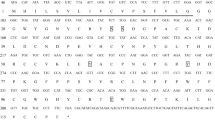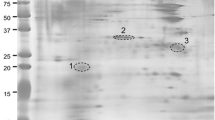Abstract
We report here the complete cDNA sequence of a nonfibrillar collagen (COLch) isolated from the marine sponge Chondrosia reniformis, Nardo 1847 using a PCR approach. COLch cDNA consists of 2,563 nucleotides and includes a 5′ untranslated region (UTR) of 136 nucleotides, a 3′ UTR of 198 nucleotides, and an open reading frame encoding for a protein of 743 amino acids with an estimated M r of 72.12 kDa. The phylogenetic analysis on the deduced amino acid sequence of C-terminal end shows that the isolated sequence belongs to the short-chain spongin-like collagen subfamily, a nonfibrillar group of invertebrate collagens similar to type IV collagen. In situ hybridization analysis shows higher expression of COLch mRNA in the cortical part than in the inner part of the sponge. Therefore, COLch seems to be involved in the formation of C. reniformis ectosome, where it could play a key role in the attachment to the rocky substrata and in the selective sediment incorporation typical of these organisms. qPCR analysis of COLch mRNA level, performed on C. reniformis tissue culture models (fragmorphs), also demonstrates that this matrix protein is directly involved in sponge healing processes and that soluble silicates positively regulate its expression. These findings confirm the essential role of silicon in the fibrogenesis process also in lower invertebrates, and they should give a tool for a sustainable production of marine collagen in sponge mariculture.






Similar content being viewed by others
Abbreviations
- COLch:
-
Chondrosia reniformis complete cDNA sequence of a nonfibrillar collagen
- ASW:
-
Artificial seawater
- ASW-SF:
-
Artificial seawater silica free supplemented with 100 U/ml penicillin and 0.1 mg/ml streptomycin
- NSW:
-
Natural seawater
- SSC:
-
Saline sodium citrate
- a. n.:
-
Accession number
References
Aarskog NK, Vedeler CA (2000) Real-time quantitative polymerase chain reaction. A new method that detects both the peripheral myelin protein 22 duplication in Charcot-Marie-Tooth type 1A disease and the peripheral myelin protein 22 deletion in hereditary neuropathy with liability to pressure palsies. Hum Genet 107:494–498
Aouacheria A, Geourjon C, Aghajari N, Navratil V, Deléage G, Lethias C, Exposito JY (2006) Insights into early extracellular matrix evolution: spongin short chain collagen-related proteins are homologous to basement membrane type IV collagens and form a novel family widely distributed in invertebrates. Mol Biol Evol 23:2288–2302
Bavestrello G, Burlando B, Sarà M (1988) The architecture of the canal systems of Petrosia ficiformis and Chondrosia reniformis studied by corrosion casts. Zoomorphology 108:161–166
Bavestrello G, Arillo A, Benatti U, Cerrano C, Cattaneo-Vietti R, Cortesogno L, Gaggero L, Giovine M, Tonetti M, Sarà M (1995) Quartz dissolution by the sponge Chondrosia reniformis (Porifera, Demospongiae). Nature 378:374–376
Bavestrello G, Benatti U, Calcinai B, Cattaneo-Vietti R, Cerrano C, Favre A, Giovine M, Lanza S, Pronzato R, Sarà M (1998) Body polarity and mineral selectivity in the demosponge Chondrosia reniformis. Biol Bull 195:120–125
Bavestrello G, Benatti U, Cattaneo-Vietti R, Cerrano C, Giovine M (2003) Sponge cell reactivity to various forms of silica. Microsc Res Tech 62:327–335
Béthoux JP, Morin P, Chaumery C, Connan O, Gentili B, Ruiz-Pino D (1998) Nutrients in the Mediterranean Sea, mass balance and statistical analysis of concentrations with respect to environmental change. Mar Chem 63:155–169
Blumberg B, MacKrell AJ, Fessler JH (1988) Drosophila basement membrane procollagen alpha I(IV). II. Complete cDNA sequence, genomic structure and general implications for supramolecular assemblies. J Biol Chem 263:18328–18337
Bonasoro F, Wilkie IC, Bavestrello G, Cerrano C, Candia Carnevali MD (2001) Dynamic structure oft he mesohyl in the sponge Chondrosia reniformis (Porifera, Demospongiae). Zoomorphology 121:109–121
Boute N, Exposito J, Esnault N, Vacelet J, Noro N, Miyazaki K, Yoshizato K, Garrone R (1996) Type IV collagen in sponges, the missing link in basement membrane ubiquity. Biol Cell 88:37–44
Carlisle EM (1972) Silicon: an essential elemement for the chick. Science 178:619–621
Carlisle EM (1980) Biochemical and morphological changes associated with long bone abnormalities in silicon deficiency. J Nutr 110:1046–1056
D’Alessio M, Ramirez F, Suzuki HR, Solursh M, Gambino R (1998) Structure and developmental expression of a sea urchin fibrillar collagene gene. Proc Natl Acad Sci USA 86:9303–9307
Deutzman R, Fowler S, Zhang X, Boone K, Dexter S, Boot-Handford RP, Rachel R, Sarras MP Jr (2000) Molecular, biochemical and functional analysis of a novel and developmentally important fibrillar collagen (HCol-I) in hydra. Development 127:4669–4680
Ehrlich H (2010a) Chitin and collagen as universal and alternative templates in biomineralization. Int Geol Rev 52:661–699
Ehrlich H (2010b) Spongin, in biologically inspired systems. In: Gorb SN (ed) Biological materials of marine origin: invertebrates, vol 1. Springer, New York, pp 245–256
Ehrlich H, Worch H (2007) Collagen, a huge matrix in glass-sponge flexible spicules of the meter-long Hyalonema sieboldi. In: Bäuerlein E (ed) Handbook of biomineralization: the biology of biominerals structure formation, vol 1. Wiley, Weinheim, pp 23–41
Ehrlich H, Heinemann S, Heinemann C, Simon P, Bazhenov VV, Shapkin NP, Born RKR, Tabachnick KR, Hanke T, Worch H (2008) Nanostructural organization of naturally occurring composites—part I: silica-collagen-based biocomposites. Nanomater, Article ID 623838
Ehrlich H, Deutzmann R, Brunner E, Cappellini E, Koon H, Solazzo C, Yang Y, Ashford D, Thomas-Oates J, Lubeck M, Baessmann C, Langrock T, Hoffmann R, Wörheide G, Reitner J, Simon P, Tsurkan M, Ereskovsky AV, Kurek D, Bazhenov VV, Hunoldt S, Mertig M, Vyalikh DV, Molodtsov SL, Kummer K, Worch H, Smetacek V, Collins MJ (2010) Mineralization of the metre-long biosilica structures of glass sponges is templated on hydroxylated collagen. Nat Chem 2:1084–1088
Exposito JY, Garrone R (1990) Characterization of a fibrillar collagen gene in sponges reveals the early evolutionary appearance of two collagen gene families. Proc Natl Acad Sci U S A 7:6669–6673
Exposito JY, Ouazana R, Garrone R (1990) Cloning and sequencing of a Porifera partial cDNA coding for a short-chain collagen. Eur J Biochem 190:401–406
Exposito JY, Le Guellec D, Lu Q, Garrone R (1991) Short chain collagens in sponges are encoded by a family of closely related genes. J Biol Chem 266:21923–21928
Exposito JY, D’Alessio M, Di Liberto M, Ramirez F (1993) Complete primary structure of a sea urchin type IV collagen alpha chain and analysis of the 5′ end of its gene. J Biol Chem 268:5249–5254
Exposito J, Cluzel C, Garrone R, Lethias C (2002) Evolution of collagen. Anat Rec 268:302–316
Fowler SJ, Jose S, Zhang X, Deutzmann R, Sarras MP Jr, Boot-Handford RP (2000) Characterization of hydra type IV collagen: type IV collagen is essential for head regeneration and its expression is up-regulated upon exposure to glucose. J Biol Chem 275:39589–39599
Friess W (1998) Collagen—biomaterial for drug delivery. Eur J Pharm Biopharm 45:113–136
Frohman MA (1990) PCR protocols. In: Innis MA, Gelfand DH, Sninsky JJ, White TJ (eds) A guide to methods and applications. Academic, San Diego
Frohman MA, Dush MK, Martin GR (1988) Rapid production of full-length cDNAs from rare transcripts: amplification using a single gene-specific oligonucleotide primer. Proc Natl Acad Sci USA 85:8998–9002
Garrone R, Hu A, Junqua S (1975) Fine structure and physiocochemical studies on the collagen of the marine sponge Chondrosia reniformis Nardo. J Ultrastruct Res 52:261–275
Green D, Howard D, Yang X, Kelly M, Oreffo RO (2003) Natural marine sponge fiber skeleton: a biomimetic scaffold for human osteoprogenitor cell attachment, growth, and differentiation. Tissue Eng 9:1159–1166
Guo XD, Kramer JM (1989) The two Caenorhabditis elegans basement membrane (type IV) collagen genes are located on separate chromosomes. J Biol Chem 264:17574–17582
Heinemann S, Ehrlich H, Douglas T, Heinemann C, Worch H, Schatton W, Hanke T (2007) Ultrastructural studies on the collagen of the marine sponge Chondrosia reniformis Nardo. Biomacromolecules 8:3452–3457
Krasko A, Lorenz B, Batel R, Schröder HC, Müller IM, Müller WE (2000) Expression of silicatein and collagen genes in the marine sponge Suberites domuncula is controlled by silicate and myotrophin. Eur J Biochem 267:4878–4887
Leys SP, Nichols SA, Adams EDM (2009) Cell–cell signaling drives the evolution of complex traits. Integr Comp Biol 49:167–177
Maehira F, Iinuma Y, Eguchi Y, Miyagi I, Teruya S (2008) Effect of soluble silicon compound and deep sea water on biochemical and mechanical properties of bone and the related gene expression in mice. J Bone Miner Metab 26:446–455
Nickel M, Brümmer F (2003) In vitro sponge fragment culture of Chondrosia reniformis (Nardo, 1847). J Biotechnol 100:147–159
Nicklas M, Schatton W, Heinemann S, Hanke T, Kreuter J (2009a) Preparation and characterization marine sponge collagen nanoparticles and employment for the transdermal delivery of 17beta-estradiol-hemihydrate. Drug Dev Ind Pharm 35:1035–1042
Nicklas M, Schatton W, Heinemann S, Hanke T, Kreuter J (2009b) Enteric coating derived from marine sponge collagen. Drug Dev Ind Pharm 35:1384–1388
Pahler S, Blumbach B, Müller IM, Müller WEG (1998) Putative multiadhesive protein from the marine sponge Geodia cydonium: cloning of the cDNA encoding a fibronectin, anSRCR, and a complement control protein module. J Exp Zool 282:332–343
Reddy GK, Enwemeka CS (1996) A simplified method for the analysis of hydroxyproline in biological tissues. Clin Biochem 29:225–229
Rivaro P, Grotti M, Povero P, Misic C, Castellano M (2000) Environmental quality evaluation of Ligurian Sea coastal waters. Ann Chim–Rome 90:113–128
Schröder HC, Boreiko A, Korzhev M, Tahir MN, Tremel W, Eckert C, Ushijima H, Müller IM, Müller WE (2006) Coexpression and functional interaction of silicatein with galectin: matrix guided formation of siliceous spicules in the marine demosponge Suberites domuncula. J Biol Chem 281:12001–12009
Swatschek D, Schatton W, Kellermann J, Müller WE, Kreuter J (2002) Marine sponge collagen: isolation, characterization and effects on the skin parameters surface—pH, moisture and sebum. Eur J Pharm Biopharm 53:107–113
Timpl R (1984) In: Piez KA, Reddi AH (eds) Extracellular matrix biochemistry. Elsevier, New York, pp 159–190
Vandesompele J, De Preter K, Pattyn F, Poppe B, Van Roy N, De Paepe A, Speleman F (2002) Accurate normalization of real-time quantitative RT-PCR data by geometric averaging of multiple internal control genes. Genome Biol 3(7):research0034
Wilkie IC, Parma L, Bonasoro F, Bavestrello G, Cerrano C, Carnevali MD (2006) Mechanical adaptability of a sponge extracellular matrix: evidence for cellular control of mesohyl stiffness in Chondrosia reniformis Nardo. J Exp Biol 209:4436–4443
Acknowledgments
This work was supported in part by grants from EU (FP7, grant agreement no: 266033-SPonge Enzymes and Cells for Innovative AppLications–SPECIAL) to MG and in part from Regione Liguria (P.O. C.R.O. FSE 2007–2013, Asse IV, Capitale umano, Ob. specifico i/4,l/5, delibera nr.956 del 14/07/2009) to MG. The authors are indebted to Prof. Antonio De Flora for the stimulating scientific discussions and for critical reading of the manuscript.
Author information
Authors and Affiliations
Corresponding author
Rights and permissions
About this article
Cite this article
Pozzolini, M., Bruzzone, F., Berilli, V. et al. Molecular Characterization of a Nonfibrillar Collagen from the Marine Sponge Chondrosia reniformis Nardo 1847 and Positive Effects of Soluble Silicates on Its Expression. Mar Biotechnol 14, 281–293 (2012). https://doi.org/10.1007/s10126-011-9415-2
Received:
Accepted:
Published:
Issue Date:
DOI: https://doi.org/10.1007/s10126-011-9415-2




